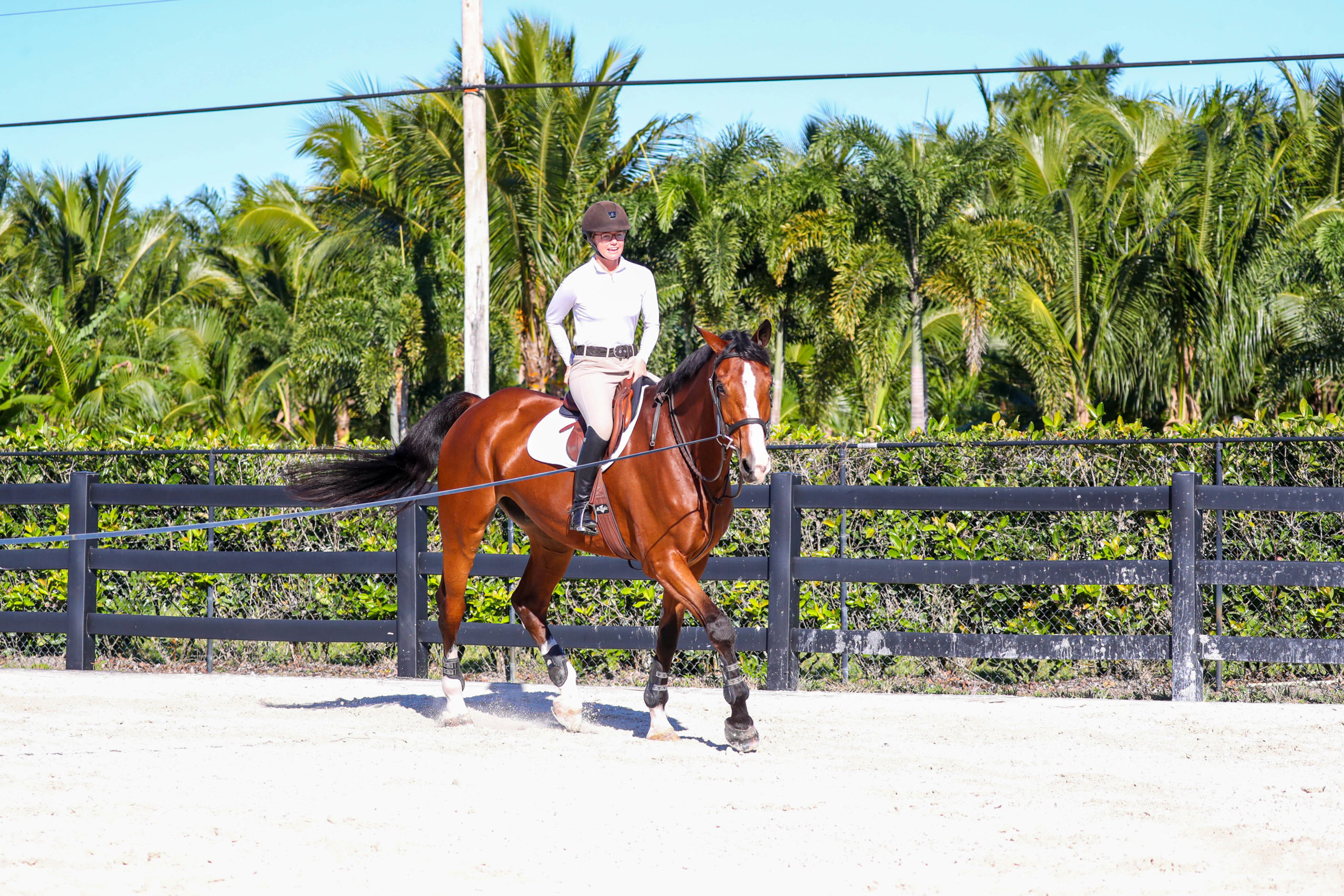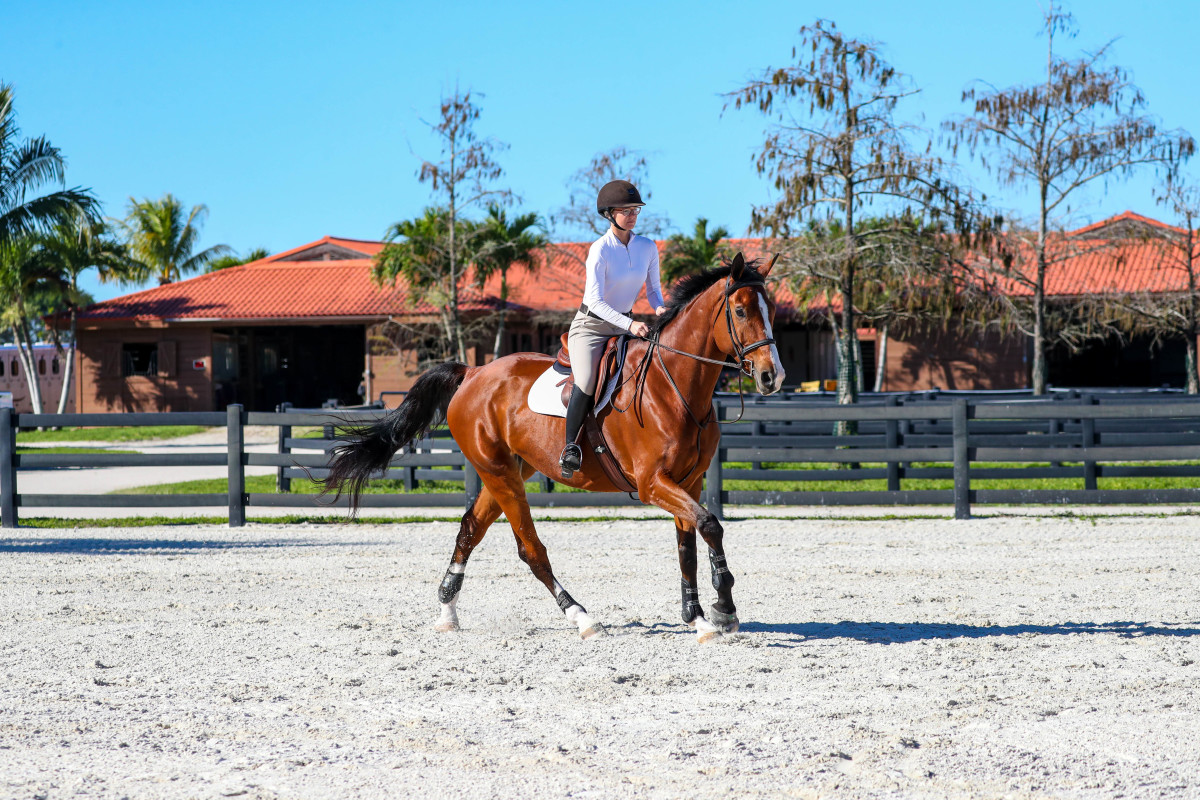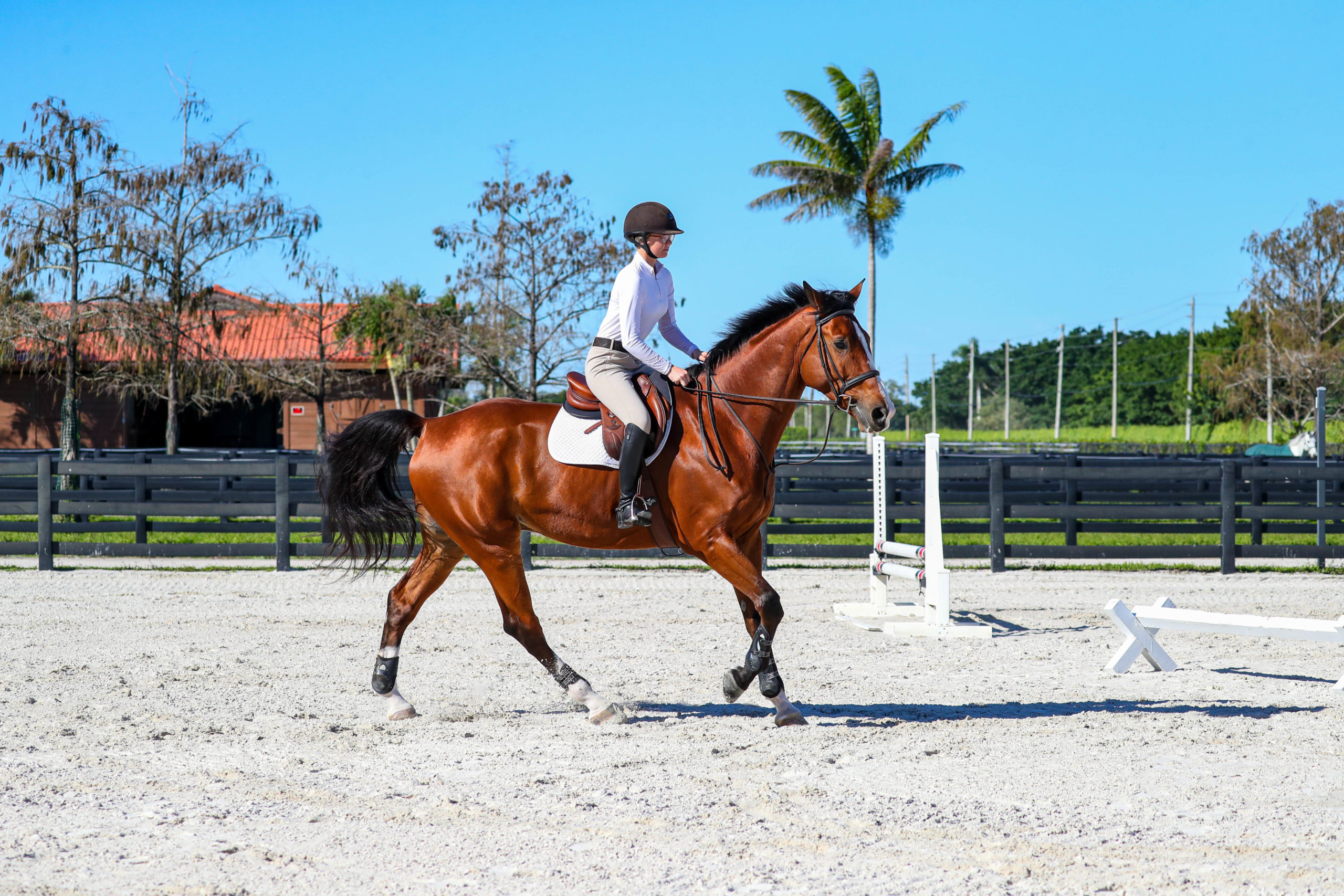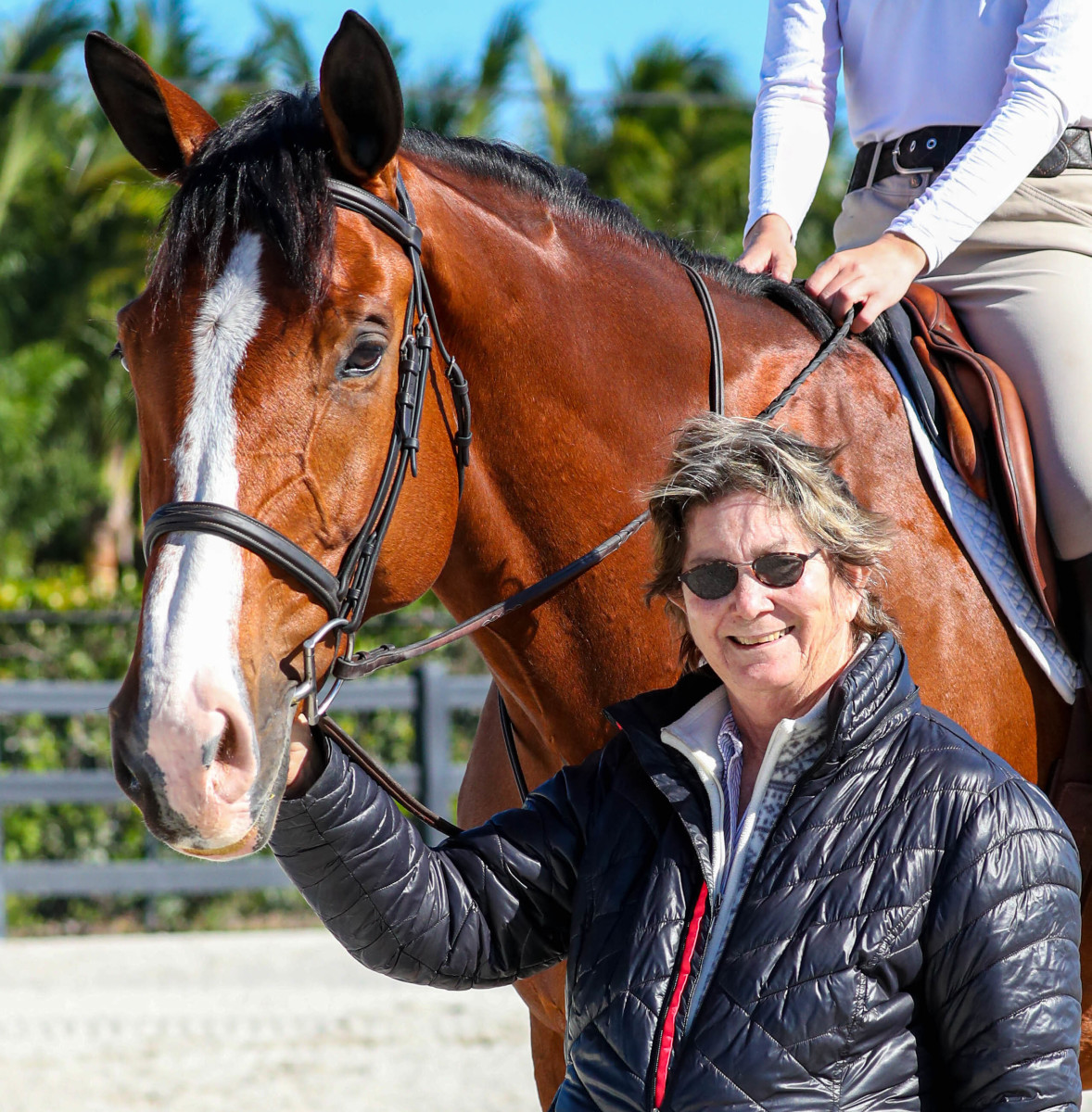One of the most important things you can do to improve your riding is address stiffness in your body. It’s the root of many rider problems. If your back is overarched and stiff, you can sit on the saddle, but not “in” it—your body won’t move fluidly with your horse’s motion. Even worse, your hollow back will drive your seat bones down into your horse’s back, causing him to raise his head, hollow and stop pushing off his hind legs.
Similarly, stiff hands and arms can’t follow the horse’s mouth smoothly or apply aids in an effective manner. If your elbows are locked, for example, you’ll unconsciously tug on the bit every time you post. If your horse is wearing a non-jointed bit, he’ll feel these tugs on his tongue and the corners of his mouth. If he’s wearing a jointed bit, he will feel the tugs in those places, plus two even more sensitive places: the roof of his mouth and the bars (the gaps between his teeth). Depending on your horse’s sensitivity, this discomfort can make him tense, reluctant to go forward or heavy and unresponsive in the bridle.
Rider stiffness often results from a misguided attempt to avoid bouncing. Trying to sit still in the saddle makes you freeze your body and hold your breath, which causes you to bounce even more. That’s why hearing trainers tell their students to “sit still” drives me nuts! To correctly follow your horse’s motion, you must allow your body to move. The only time you should be still is at the halt.
Over fences, any rigidity in your arms, back or legs makes navigating a technical course nearly impossible. It can interfere with your horse’s motion and cause discomfort in his mouth and/or back. As a result, he will either refuse to go forward from your leg aids or tune out your rein aids and rush the fences. This will affect every phase of his jump, from where he leaves the ground to midair and landing. For example, if you perch in a forward position near his neck—ahead of the motion—and hold your body absolutely still in the approaches to jumps, your horse might stop, add a stride or ignore you and speed up. He might also hollow his back, jumping in a shape that’s undesirable in hunter classes and more likely to cause a knockdown with his front legs in jumper classes. Meanwhile, the thrust of his jump might push your weight onto the back of the saddle, causing him to drop his hind legs and possibly knock down a rail with them.
Fortunately, there are some very easy ways to combat stiffness. The following four exercises will show you how.
Exercise 1: Breathe Away the Stiffness
One of your most powerful tools is your breath. Breathing relaxes your muscles, allowing you to better communicate with your horse through sensitive aids. Holding your breath, on the other hand, prevents your body from oxygenating properly, starting with your extremities—your legs and hands. To remind yourself how important this is, think about what happens in death: You stop breathing and your body stiffens in rigor mortis. That’s a good reason to keep breathing!

Susan J. Stickle
Holding your breath also deprives your brain of oxygen, which will either prevent you from thinking at all or cause your mind to race in so many directions that you can’t possibly do everything it’s telling you to do. So keep breathing to keep your brain thinking clearly.
The best way to control your breathing is to talk. It’s physiologically impossible to talk without breathing. Try the following exercise on the flat, either with or without stirrups:
Pick up a sitting trot on a large circle. Speaking in a loud, clear voice, count by fives from zero to 100 in rhythm with your horse’s step: “Five, 10, 15, … .” When you reach 100, count backward by fives from 100 to zero: “100, 95, 90, … .” Then count up to 100 and back by twos. If you want to keep going, do it by threes.
This exercise will take your mind off of trying to sit the trot and force you to focus on your counting and breathing instead. You’ll notice your entire body begin to relax and sink “into” the horse—moving more smoothly with his motion.
If your voice becomes really squeaky, that means you’re holding your breath. You’ll also feel very tired! Ask a friend to stand nearby and let you know if she hears this happening: “I can’t hear you—better start to breathe!”
You can also do this exercise on the longe line. If your sitting trot is not totally established yet, tie your reins in a knot and put them on your horse’s neck. Then grasp the pommel of the saddle with your outside hand. Reach your inside hand back to hold the cantle.
Try this exercise at the canter, too, counting in rhythm with your horse’s canter steps. Practice it at both gaits regularly in your schooling sessions or lessons for at least a month. Then go back to it whenever you feel your body tensing up.
Once you’ve made this connection between breathing and relaxation, look for other ways to incorporate it into your riding. For example, if you’re struggling with a particular skill or exercise at home, set it aside for a moment and sit the trot on a circle. At 12 o’clock, 3 o’clock, 6 o’clock and 9 o’clock, take a few slow, deep breaths. This will momentarily take your mind off whatever else you’re working on and help you relax your body—so you can go back to that other task in a much better state.
Do the same when you’re in a flat class at a horse show, picking four places around the ring (such as the middle of each side of the arena) to take deep breaths. During your course walks for jumping classes choose four places on course to take those breaths. You’ll be amazed at what a difference it makes.
Exercise 2: Soften Stiff Arms
Many riders stiffen their arms in an effort to keep their hands still. This results in accidental tugs on the bit. To follow your horse’s mouth correctly (and kindly), you must allow movement in your elbows. Try this exercise:
Pick up a posting trot and rest your hands on either side of your horse’s withers or a few inches farther up his neck. You may have to bring your shoulders more forward than usual to do this. Be sure that you keep a straight line through the back of your wrist (not twisting your wrists or cocking your hands in or out).
As you trot along, let your elbows do all the work necessary to keep your hands on your horse’s neck. Notice how they open when you rise out of the saddle and close as you sit back down. Continue this exercise until that feeling becomes very comfortable. Then take your hands off his neck and bring your shoulders back to their normal position while maintaining that elastic motion in your elbows. This is the first step toward developing independent hands.
Exercise 3: Endless Reins
This is another great exercise to loosen up your arms and hands while also teaching you to rely more on your legs than your reins to turn your horse. Only try it on a quiet horse, preferably one who responds to voice commands (such as “walk” and “whoa,” which you or your trainer can use if he’s not responding to your other aids). Always do this exercise in a safe, enclosed arena with the gate closed.
Go to a home-supply store to find cotton laundry line a little thicker than a typical clothesline. Buy enough to match the length of your reins, plus another 8 to 10 inches to accommodate a knot. Make sure the line isn’t covered with any sort of wax/coating that makes it slippery.
Run the laundry line through one ring of your horse’s bit, then under his chin and through the other ring. Bring the ends around his neck and knot them together, creating a continuous loop. Tie your real reins in a knot and rest them on your horse’s neck. Then pick up the laundry-line “reins” and walk your horse around the arena.
You’ll quickly learn that it’s much more difficult to steer with this rein loop than with regular reins, since it slides through the bit. If you just grab the inside rein to turn, the loop will pull your other hand forward. The stiffer you are in your arms, the more challenging this will be. The only way to communicate effectively with your horse is to soften the joints in your arms and turn with both hands at the same time. When turning your horse or circling, use a slight opening inside “rein”: Bring your inside hand 2 to 3 inches toward the direction you want to turn. At the same time, use an indirect outside “rein”: Move your outside hand toward the withers, so the rope comes closer to that side of his neck or even presses against it. Most importantly, avoid letting your outside hand move forward toward your horse’s mouth. Meanwhile, close the calf of your inside leg against your horse’s side at the girth, acting like a hinge that his body bends around. Close the calf of your outside leg a few inches behind the girth to turn his body in the direction you want to go.
Be careful to keep the knot of the loop reins on one side of your horse’s neck, not under his chin, against the bit (which would be cheating, as it would act on him like normal reins), in your hand or between your hands. If you encounter any situation that might be dangerous—such as approaching another horse too closely—pick up your regular reins temporarily to steer clear, then drop the knot back on the crest of the mane and go back to riding with just the loop reins.
This takes lots of practice, but it’s an invaluable skill to learn. (It can also be very entertaining for onlookers, as riders often get stuck in a corner before they figure out how to use their aids correctly.) It will help you develop more control in all your riding—without tension. Also, as you learn to ride more with your legs than your hands, your horse will likely respond by becoming lighter in the bridle and more responsive to soft aids.
Once you get the hang of this exercise, try it at the trot and canter, too. More advanced riders can even remove their regular reins from the bridle entirely—and, if they’re comfortable, ride with the loop reins over small jumps. A great test is to jump a cavalletti on a circle.
Exercise 4: Three Positions for Jumping
Trying to maintain a perfect position on course is another common cause of rider stiffness. Instead of “posing” in the saddle, you must be constantly transitioning between different positions to support your horse as necessary. In general, the farther you bring your shoulders back and the more weight you press down into the seat of the saddle, the stronger your rein and leg aids become. During any jumping course or exercise, there are three basic positions you need to be able to slip easily into and out of:
Light two-point position—Similar to a regular two-point position, in which you balance on your legs (your two “points”), except in this case, instead of lifting your seat completely out of the saddle, you drop some weight lightly down onto your pubic bone and the front of your seat bones, keeping your crotch behind the pommel of the saddle, with your hip angle still closed.

Susan J. Stickle
Light three-point position—Opening your hip angle slightly so your shoulders come back just a bit—but not so far that you fall behind the horse’s motion—and your weight is a little deeper in the saddle, distributed more evenly over your pubic bone and seat bones.

Susan J. Stickle
Full three-point position—Opening your hip angle even more so your shoulders come back in line with your hips and heels and your weight is balanced squarely over your seat bones.
On occasion, you also may need to resort to a full three-point position behind the motion: bringing your shoulders behind your hips to drive your horse forward, for example, if he balks at a jump, or to create more leverage with your reins if he tries to run off with you. But the three positions above are the most common ones riders need on course.
As you pick up your canter at the beginning of a course, you’ll generally want to be in your light two-point position, allowing your horse to move freely underneath you without any undue pressure. In the last few strides before the first jump, sink into your light three-point, taking a bit more control of the pace and rhythm. This not only puts you in the perfect position for the thrust of your horse’s jump to push you into jumping position without getting ahead of the motion, but it also tells him where you are. Horses like to know where their riders’ weight is at that critical moment, so they don’t have to worry about getting thrown off balance. Because this position is not as deep as a full three-point position, your horse is still able to step up underneath his body on takeoff without feeling inhibited by your weight.
Whenever you need even more control, drop into your full three-point position. For example, in a jumper class that has a very short turn to a fence, using your full three-point on the turn will strengthen your leg and rein aids to keep your horse on the track you’ve chosen without losing impulsion.
Practice transitioning into and out of these positions on the flat at the canter. Lift your body into a light two-point position and hold that for several strides. Then sink lightly down into your light three-point, then your full three-point. Transition slowly back up from your full three-point to your light three-point and light two-point. Repeat this until you feel a clear difference between all three positions. Now and then, throw in a regular two-point—lifting your weight completely out of the saddle—and full three-point behind the motion—bringing your shoulders back behind your hips—to feel those differences, too.
When you can cycle through all of these positions fluidly, try the exercise over fences. (More advanced riders can do this without stirrups.) Start in your light two-point on long approaches and around turns, then drop to your light three-point in the last few strides before each jump. Use your full three-point on any tight turns or when your horse needs a little more encouragement on takeoff. To be absolutely sure you’re not stiffening up, say what you’re doing out loud: for example, “Now I’m in my light two-point.” If you’re talking, you’re breathing—and if you’re focusing on your position, you won’t have time to tense up.
ABOUT KIP ROSENTHAL

As one of the country’s top hunter/jumper/equitation trainers, the late Kip Rosenthal, who passed away August 20, 2020, earned many national titles of her own before guiding multiple juniors to similar success. A U.S. Equestrian Federation “R” judge, Kip officiated at many medal finals, hunter finals and pony finals across the country. In addition to running her own business, Benchmark Farm, in Wellington, Florida, she was a practicing sport psychologist with a PhD in psychology.
This article originally appeared in the Fall 2020 issue.










